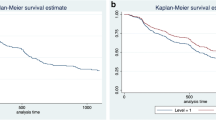Abstract
Objectives
Maintaining pulpal vitality and achieving long-term restoration success are challenging when treating advanced caries lesions. We aimed at assessing success, survival, and influencing factors of treating advanced lesions in general dental practice.
Methods
Patient record databases from six practices in Germany were assessed. Permanent posterior teeth with lesions radiographically extending into inner dentin with sensible (vital) pulps were retrospectively evaluated. Outcome parameters were success (absence of re-treatment) and survival (absence of extraction). Mean success/survival times were estimated, and effect of treatment modifiers assessed using Lee, Wei, and Amato (LWA) regression.
Results
Two hundred thirty-two patients (308 teeth) were assessed. Lesions (93 %) included proximal surfaces. Eight teeth showed preoperative intermitting or provocation pain. Thirty four % of teeth experienced pulpal exposure during excavation. Mean follow-up time was 74 months. Mean success time was 130 months. Teeth (142/308) required re-interventions, mostly due to secondary caries and restorative or endodontic complications. Only 13 teeth required extraction (mean survival time 307 months). Hazard of failure was significantly reduced in younger patients (<40 years) (hazard ratio (HR) [95 % confidence interval (CI)] 0.57 [0.35/0.91]) and teeth without preoperative pain (0.39 [0.17/0.90]). Compared with teeth receiving amalgams, those restored using cements (2.44 [1.05/3.98]) or composites (1.64 [1.15/2.38]) had higher risk of failure. Hazard of extraction was higher in teeth with pulpal exposure (4.90 [1.36/17.7] or cement restorations (23.6 [5.56/100]).
Conclusion
Teeth with advanced lesions had high risk of failure, while risk of extraction was low.
Clinical relevance
Teeth treated for advanced lesions required re-treatment frequently but were retained long term. Age, pulpal exposure, and restoration type were associated with risk of failure or extraction.

Similar content being viewed by others
References
Schwendicke F, Dörfer CE, Paris S (2013) Incomplete caries removal: a systematic review and meta-analysis. J Dent Res 92:306–314
Schwendicke F, Meyer-Lueckel H, Dorfer C, Paris S (2013) Attitudes and behaviour regarding deep dentin caries removal: a survey among German dentists. Caries Res 47:566–573
Hickel R, Manhart J (2001) Longevity of restorations in posterior teeth and reasons for failure. J Adhes Dent 3:45–64
Whitworth JM, Myers PM, Smith J, Walls AW, McCabe JF (2005) Endodontic complications after plastic restorations in general practice. Int Endod J 38:409–416
Schwendicke F, Stolpe M, Meyer-Lueckel H, Paris S, Dörfer CE (2013) Cost-effectiveness of one- and two-step incomplete and complete excavations. J Dent Res 90:880–887
Bjørndal L (1999) Treatment of deep carious lesions with stepwise excavation. A practice-based study. Tandlaegebladet 103:498–506
Bjørndal L, Thylstrup A (1998) A practice-based study on stepwise excavation of deep carious lesions in permanent teeth: a 1-year follow-up study. Community Dental Oral Epidemiol 26(2):122–128
Lee E, Wei LJ, Amato DA (1992) Cox-type regression analysis for large number of small groups of correlated failure time observation. In: Klein JP, Goel PK (eds) Survival analysis: state of the art. Kluwer Academic, Dordrect, pp 227–247
Burke FJ, Cheung SW, Mjor IA, Wilson NH (1999) Reasons for the placement and replacement of restorations in vocational training practices. Primary Care Dent 6:17–20
Ridell K, Olsson H, Mejare I (2008) Unrestored dentin caries and deep dentin restorations in Swedish adolescents. Caries Res 42(3):164–170
Ricketts D, Lamont T, Innes NP, Kidd E, Clarkson JE (2013) Operative caries management in adults and children. Cochrane Database Syst Rev 28, CD003808
Opdam NJ, Bronkhorst EM, Loomans BA, Huysmans MC (2010) 12-year survival of composite vs. amalgam restorations. J Dent Res 89:1063–1067
Opdam NJ, Bronkhorst EM, Roeters JM, Loomans BA (2007) A retrospective clinical study on longevity of posterior composite and amalgam restorations. Dent Mater 23:2–8
Skupien JA, Opdam N, Winnen R, Bronkhorst E, Kreulen C, Pereira-Cenci T, Huysmans MC (2013) A practice-based study on the survival of restored endodontically treated teeth. J Endod 39:1335–1340
Hickel R, Kaaden C, Paschos E, Buerkle V, García-Godoy F, Manhart J (2005) Longevity of occlusally-stressed restorations in posterior primary teeth. Am J Dent 18:198–211
Pallesen U, van Dijken JWV, Halken J, Hallonsten A-L, Höigaard R (2013) Longevity of posterior resin composite restorations in permanent teeth in public dental health service: a prospective 8 years follow up. J Dent 41:297–306
Plasmans PJJM, Creugers NHJ, Mulder J (1998) Long-term survival of extensive amalgam restorations. J Dent Res 77:453–460
Van Nieuwenhuysen JP, D’Hoore W, Carvalho J, Qvist V (2003) Long-term evaluation of extensive restorations in permanent teeth. J Dent 31:395–405
Burke FJ, Wilson NH, Cheung SW, Mjor IA (2001) Influence of patient factors on age of restorations at failure and reasons for their placement and replacement. J Dent 29(5):317–324
Aguilar P, Linsuwanont P (2011) Vital Pulp therapy in vital permanent teeth with cariously exposed pulp: a systematic review. J Endod 37:581–587
Bjørndal L, Reit C, Bruun G, Markvart M, Kjaeldgaard M, Nasman P, Thordrup M, Dige I, Nyvad B, Fransson H, Lager A, Ericson D, Petersson K, Olsson J, Santimano EM, Wennstrom A, Winkel P, Gluud C (2010) Treatment of deep caries lesions in adults: randomized clinical trials comparing stepwise vs. direct complete excavation, and direct pulp capping vs. partial pulpotomy. Eur J Oral Sci Eur J Oral Sci 118:290–29722
Dammaschke T, Leidinger J, Schafer E (2010) Long-term evaluation of direct pulp capping—treatment outcomes over an average period of 6.1 years. Clin Oral Investig 14:559–567
Schwendicke F, Stolpe M (2014) Direct pulp capping after a carious exposure versus root canal treatment: a cost-effectiveness analysis. J Endod 40:1764–1770
Barthel CR, Rosenkranz B, Leuenberg A, Roulet J-F (2000) Pulp capping of carious exposures: treatment outcome after 5 and 10 years: a retrospective study. J Endod 26:525–528
Al-Hiyasat AS, Barrieshi-Nusair KM, Al-Omari MA (2006) The radiographic outcomes of direct pulp-capping procedures performed by dental students. J Am Dent Assoc 137:1699–1705
Acknowledgments
We thank the dentists and their staff for allowing screening of databases and data extraction within their premises.
Author information
Authors and Affiliations
Corresponding author
Ethics declarations
Funding statement
This study was funded the authors and their institutions.
Conflict of interest
The authors have no conflict of interest to declare.
Ethical approval
All procedures performed in studies involving human participants were in accordance with the ethical standards of the institutional and/or national research committee and with the 1964 Helsinki Declaration and its later amendments or comparable ethical standards. Approval for database screening and anonymous data extraction was given by the ethics committee of the CAU Kiel (D-414/14).
Rights and permissions
About this article
Cite this article
Schwendicke, F., Krüger, H., Schlattmann, P. et al. Restoration outcomes after restoring vital teeth with advanced caries lesions: a practice-based retrospective study. Clin Oral Invest 20, 1675–1681 (2016). https://doi.org/10.1007/s00784-015-1654-6
Received:
Accepted:
Published:
Issue Date:
DOI: https://doi.org/10.1007/s00784-015-1654-6




